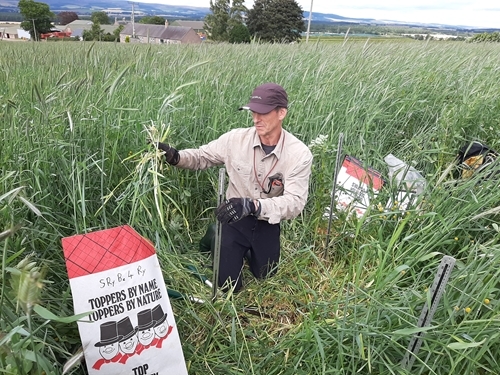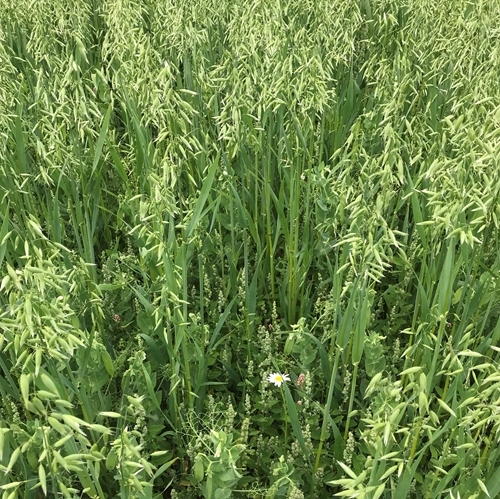Guest blog by Dr Rob Brooker of the James Hutton Institute

Vegetation sampling in a beans and rye mixture
There may be a point in the career of many researchers when they take a step away from being dispassionate observers and decide instead to get their sleeves rolled up and try to make a difference. For me, this opportunity has arisen through the SEAMS project (Sustainability in Education and Agriculture using MixtureS), funded by the Esmée Fairbairn Foundation. It aims to promote the use of crop mixtures as part of sustainable arable production systems and as a platform for knowledge exchange about food production and farmland biodiversity.
At a range of meetings, conferences and seminars over the last few years I’ve seen persuasive evidence of the disconnect between children and both the wider environment and nature, and food production. This is a problem for a number of reasons. First, children’s experiences of nature, and the extent to which they care for the natural environment, strongly impacts on their behaviour as adults. At a time when global biodiversity is in substantial and rapid decline, working with children to explain how nature works and delivers benefits for us, including the food we eat, is critical to protecting nature in the long-term.
At the same time my research work on beneficial plant-plant interactions has led me to work with colleagues on studies of crop mixtures. From a plant ecologist’s perspective, crop mixtures provide an opportunity to examine how neighbouring plants can have beneficial effects on one another. The benefits are greater biomass production per unit of land, more resistance to pests and pathogens and generally enhanced environmental resilience. In crop systems these beneficial effects can provide an alternative to some standard farming practices, for example the use of high levels of inputs of synthetic fertilisers or pesticides. If we can get them to work, crop mixtures might be one of the tools we need to get more biodiversity back into farming landscapes and to reduce some of the negative effects of farming on the environment as well as achieving more efficient production.

A barley and pea mixture from a trial plot at Balgonie in Fife
Through the SEAMS project we’re bringing these issues together. We’ve started initially with a smaller network of core sites spread across the main arable production areas of Scotland. These sites are trialling different crop mixtures to help us understand which mixtures work best where. At the same time core sites are acting as platforms for knowledge exchange, hosting visits from a wide range of groups (Covid restrictions permitting). These include other farmers, following the successful GWCT farmer clusters approach, to enable knowledge exchange about the practicalities of growing crop mixtures. We’re also working with schools to use the crop mixtures as an opportunity to find out more about sustainable food production and the ecology of farmed landscapes. Looking further ahead we’ll be reaching out to food buyers and producers to help increase the uptake and demand for products derived from crop mixtures, and to policy makers to help promote crop mixtures in future farming policy.
Obviously the Covid crisis has presented some challenges to a project which is so heavily based on face-to-face meetings and site visits. We’ve had to find new ways this summer to keep the project running, and to deliver knowledge exchange without being able to go into the field. To this end we’ve been involved in producing videos, webinars, and podcasts (which can be found from our SEAMS project website), all of which consider the potential benefits and challenges of growing crop mixtures.
Our next big challenge is to expand our network of trials sites by finding “network site” farmers willing to grow at least one crop mixture with two or preferably more components, and monoculture plots of the components. Network sites won’t have any obligation to have site visits, and funding is available from the SEAMS project to help cover the cost of getting involved. We’d be delighted to hear (via SEAMS@hutton.ac.uk) from farmers that want to try growing even just a small area of crop mixtures, or from those already growing mixtures but aren’t yet involved in the SEAMS project.
Overall, we feel that working together we can help make the most of the opportunities that crop mixtures bring to deliver sustainable farming and to reconnect children to food production and their environment.